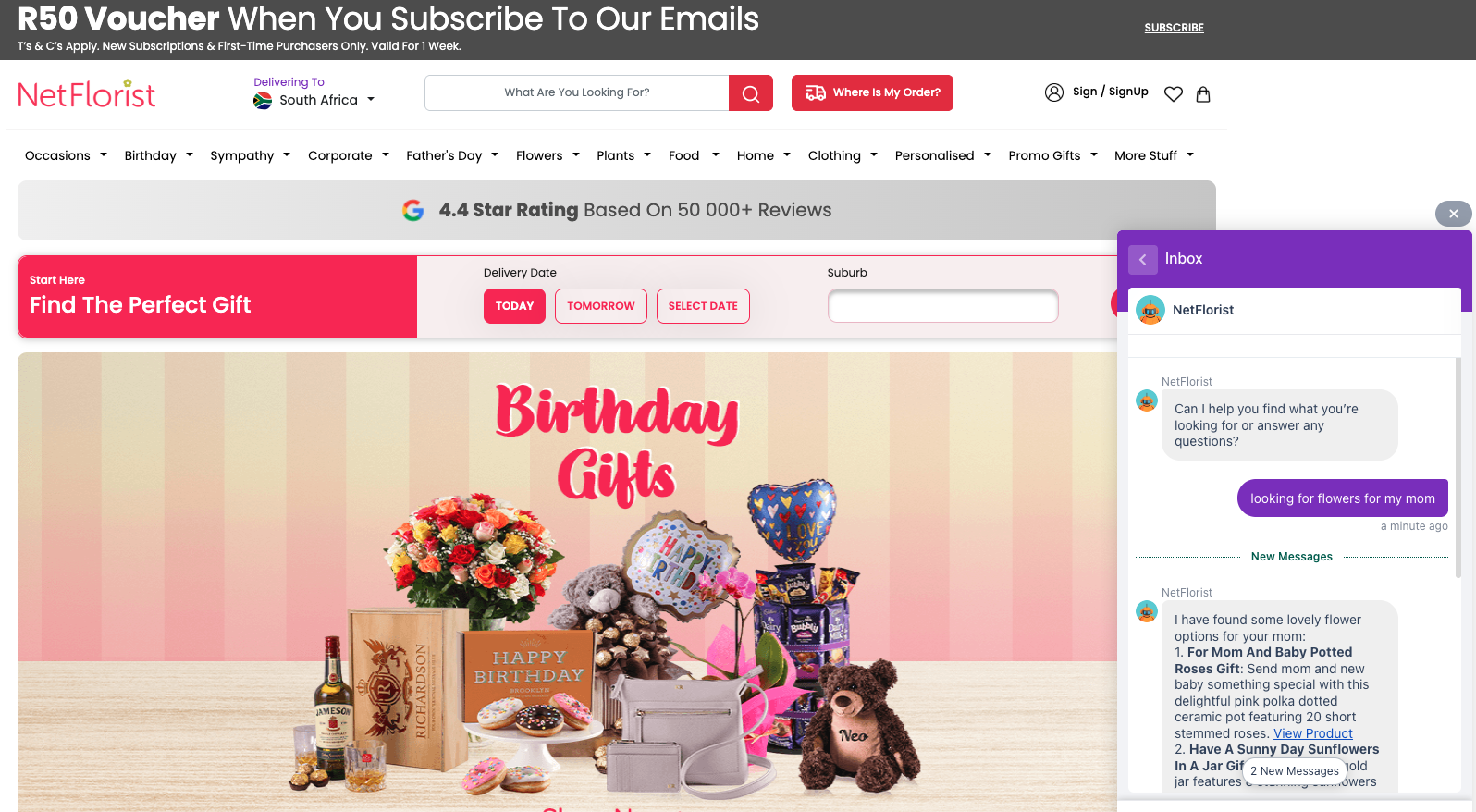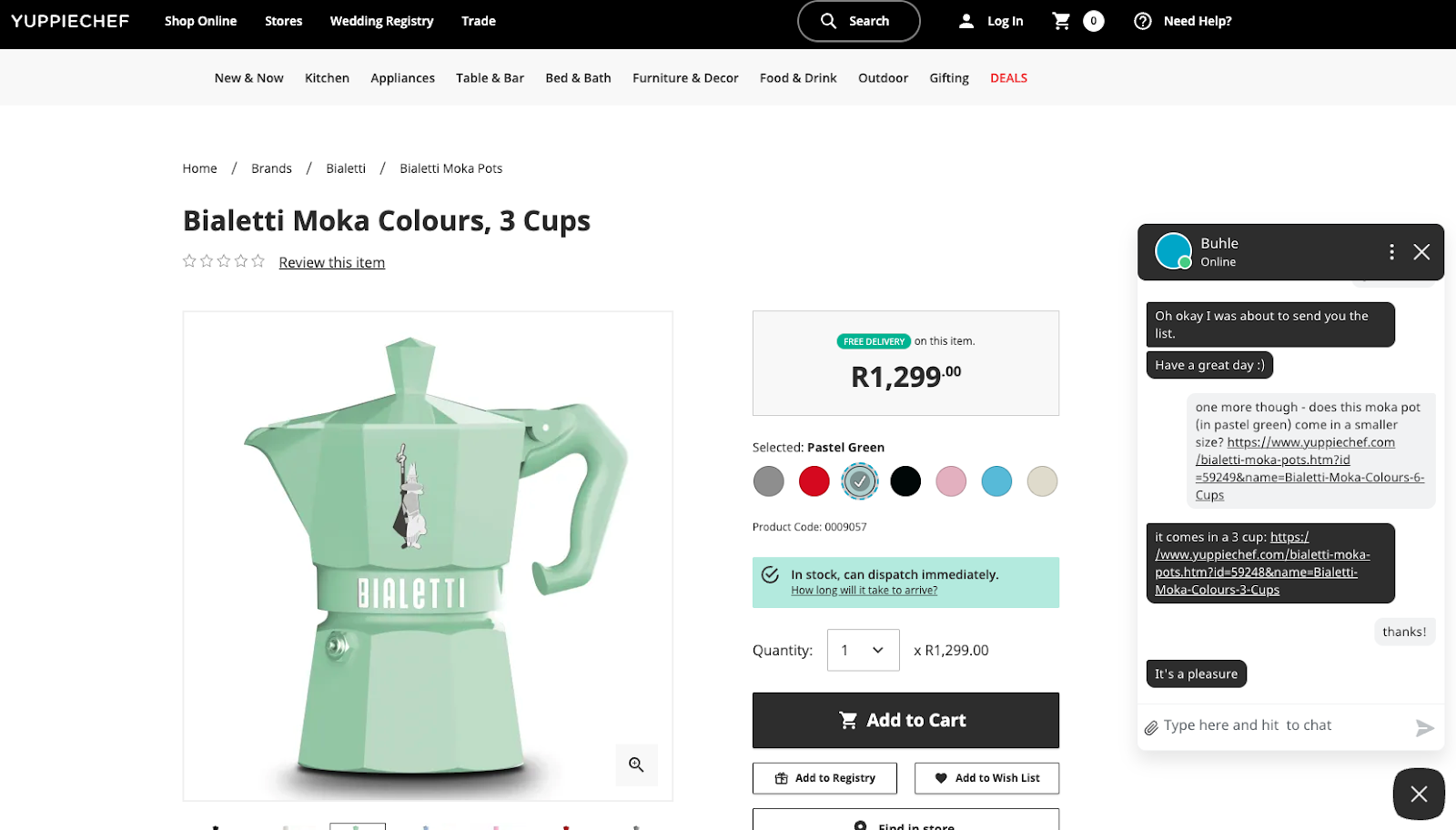
Conversational commerce: The ultimate guide
Customers prefer brands that offer convenient ways to shop and offer personalised experiences. To remain competitive, many businesses are turning to conversational commerce as a way to rapidly accelerate growth – whether they are an online business, brick and mortar business, or both.

It’s not just technology that’s getting smarter – consumers are, too. Customers flock to brands that understand them, that offer convenient ways to shop and that have personalised experiences. To remain competitive, businesses must adapt their customer engagement strategies for an increasingly digital and “instant gratification” world. To do that, many are turning to conversational commerce as a way to rapidly accelerate growth – whether they are an online business, brick and mortar business or both.
- Global retail e-commerce is expected to reach $6.4 trillion by the end of 2025, representing over 20% of total retail sales.
- South Africa’s e-commerce market is estimated to grow at a CAGR of 8.79%, reaching $74.79 billion by 2033.
- Global conversational commerce is estimated to reach $41 billion by 2030.
- In South Africa, 51.7% of e-commerce purchases are made via mobile phones.
- A total of 21.9 million South Africans are expected to be on WhatsApp by 2029.
- Companies like Google, Expedia and Walmart are integrating generative AI in their conversational e-commerce models to make the experience even more seamless.
What is conversational commerce and how did it start?
Conversational commerce refers to the use of chat, voice commands and similar messaging tools to drive sales and improve customer experience. It typically takes place via messaging apps, social media platforms, chatbots and voice assistants.
Chris Messina, the product designer who created the hashtag, came up with the term "conversational commerce" in 2015. At that time, several key developments were shaping the digital landscape:
- Facebook bought WhatsApp, despite the tool earning very little revenue at the time
- Voice assistants were gaining popularity. Amazon Alexa introduced a feature to enable voice-activated purchasing
- Businesses increasingly used social media platforms like Instagram to attract and engage with customers
Companies use conversational commerce to convert leads because it allows customers to interact with the brand wherever they are. When used well, the captured data on customer purchasing behaviour and queries can provide valuable insights that can be used to optimise the customer experience and make better business decisions.
How does conversational commerce differ from traditional e-commerce?
Both traditional and conversational e-commerce aim to engage customers, answer queries and convert leads into sales - the difference is in how they do it.
Shopping experience:
In traditional e-commerce, the customer navigates the shopping and purchase journey on their own. They search for the brand, explore their products and go through the checkout process by themselves. If they have a question, they can try to find the answer on the brand’s website or through other websites and platforms, or they can choose to access support by separate channels such as telephone.
In conversational commerce, the customer initiates the purchase journey but can be guided throughout the process by interacting either with an employee or with a bot. A chatbot or live agent can anticipate the customer’s needs, cross-sell products, answer questions, respond to issues and even go so far as to enable a purchase and transaction to occur, all within the chat. This results in a quicker and more personalised discovery process, with the convenience of a messaging tool.
In emerging markets, where desktop-based e-commerce shopping is less common, consumers often find brands on platforms like Instagram and engage via DM to query inventory, share photos, place orders and pay – without ever visiting a website.
Engagement channels:
Traditional e-commerce relies on websites, apps and paid adverts to increase leads and sales. It also expects the customer to call or email to address any issues.
Digital-native audiences like Gen Z are unlikely to call, and waiting multiple business days to get an answer to a query creates frustration in the “same-day” delivery world. That shopper would have already moved on. Conversational commerce not only expands the communication touchpoints the business has with their customers, it also meets their customers wherever they are and with the immediacy they expect.
Types of conversational commerce
Conversational commerce spans several digital channels, each offering unique opportunities to engage with customers. In all instances, should the customer wish to proceed with a purchase, a payment link can also be sent – or, thanks to the emergence of tools like MCP, perhaps even complete a payment – within the chat itself, creating a more seamless and unified experience.

What are the benefits of conversational commerce?
- Uses convenient engagement channels
Conversational commerce removes friction, allowing businesses to communicate with customers directly through familiar platforms. According to Meltwater’s latest digital and social media statistics:
- WhatsApp is the most popular social media platform, with a 93.8% user rate.
- Social media and instant messaging platforms are used by 99.3% and 99% of internet users respectively.
- 63% of South African users visit social media to engage with brand content.
A business that has an omnichannel model can benefit from using conversational commerce to expand their touchpoints while providing a consistent experience across channels.
- Builds customer loyalty and trust
South African consumers often prioritise instant rewards over long-term brand loyalty, making it increasingly difficult for brands to build and maintain strong customer retention.
Conversational commerce supports loyalty by delivering value through real-time interactions. Allowing customers to ask questions, confirm stock and receive real-time updates on a platform like WhatsApp helps bridge trust gaps and build confidence in digital purchases. Plus it often allows them to interact with a real human, which makes the process feel a lot more personal.
Each customer interaction generates valuable data on spending behaviour. These insights also help merchants optimise personalised experiences, product and marketing strategies.
- Enhanced customer support and operational efficiency
Businesses with lean customer support teams can use AI conversational commerce tools to provide 24/7 service that feels personal. These chatbots can handle routine queries, providing teams with more capacity to manage more complex items and exceptions.
In more advanced solutions, these bots can also develop natural language skills, learn about individual customers and initiate specific support queries or real transactions.
- Improves conversion rates
In retail, conversational commerce can be used to encourage customers to make purchases.
- Messaging apps: In-chat product discovery and personalised recommendations make finding something to buy simpler. South Africa’s mobile data costs are considerably high, so being able to browse and pay directly through a platform like WhatsApp reduces data usage, encouraging more customers to shop online.
- Social media platforms: In-app buttons guide users to the brand’s portfolio, providing them with an opportunity to experience and engage with the brand and initiate purchases without leaving the platform.
- Websites: Conversational AI and live agents can upsell and cross-sell based on browsing history and historical purchases. Real-time support nurtures buyer confidence and helps reduce cart abandonment rates.
- Voice assistants: Over 20% of the global population use voice search, with nearly 40 million people using voice assistants for shopping. These hands-free tools are convenient for prompting routine purchases, like groceries and other low-stakes items.
- Lower barrier to entry for SME and informal businesses
Conversational commerce turns everyday chat apps into fully functional online sales channels. In South Africa, where many merchants operate without a website, being able to market, sell, and support customers via WhatsApp enables them to compete and grow with minimal overhead.
- Integrates naturally into a unified commerce strategy
Unified commerce connects all sales channels with centralised, real-time data on products, orders, returns and other customer-merchant interactions. Conversational commerce naturally fits with this strategy as it requires the same real-time data to provide customers with reliable information. For example, a merchant should be able to help a customer track an order they made on their website on WhatsApp.
Payments also plays a key role here. With solutions like payment links, customers can experience the same payments options and flow whether shopping through chat or on a full checkout page.
Examples of conversational commerce in practice in South Africa
South African businesses are increasingly using conversational commerce to drive sales and customer engagement.
- FlySafair
FlySafair uses WhatsApp to offer convenient flight booking and management support. They have also introduced Lindi - an AI chatbot that answers questions, creates bookings and helps manage existing reservations.


- Capitec
Capitec, one of South Africa’s leading retail banks with over 24.1 million clients, offers 24/7 services on WhatsApp. Their chatbot allows customers to:
- Switch salaries and debit orders
- Report lost or stolen card
- View account balances
- Access product information
- Track existing queries
- NetFlorist
NetFlorist is an online florist and gifting service that delivers across the country. Their website has an AI chatbot that can help customers navigate their catalogue and find the perfect gift quickly.

- YuppieChef
Yuppiechef, a premium homeware retailer, uses live agents on its online store to assist customers with product discovery, queries, and order support.

- Pineapple Insurance
Pineapple is an insurtech company focused on young adults and millennials—digital natives who are comfortable using online services. To convert leads efficiently, the company uses an AI bot to provide quotes, manage policies, and handle queries.

Ready to start the conversation?
Stitch supports merchants and enterprises to streamline digital payments through e-commerce and messaging platforms. We optimise digital checkouts through a high-performance payments gateway that has the agility to process payments across every channel, and can offer simple payment links that make it easy to launch a payment flow without disrupting the chat.
Let’s talk. Find out how our unified commerce solution and AI-powered WhatsApp Assistant can scale your e-commerce business.
Frequently Asked Questions
How do I integrate conversational commerce with my payments system?
Use secure payment links or embedded checkouts within messaging platforms. Stitch enables seamless, compliant payments without disrupting the conversation.
What features should I look for in a conversational commerce platform?
Look for in-chat payments, real-time tracking, chatbot automation, machine learning and CRM integration. Choose features that align with your customer journey and growth strategy.
What platforms are best for conversational commerce in South Africa?
WhatsApp is the dominant platform due to its high penetration rate. Chatbots and live agents on websites are also widely used. The best choice depends on where your target audience is most active.
How long does it take to implement conversational commerce?
The timeline depends on the complexity of the setup. Simple chatbot flows on WhatsApp or a website can be launched in a few days. More advanced integrations - such as AI, payment gateways, or CRM syncing may take a few weeks.
What does the future of conversational commerce look like?
Conversational commerce is expected to become even more intelligent and seamless as it continues to be driven by AI advancements such as AI agents. We’ll see greater use of voice assistants, hyper-personalised product recommendations and real-time support, making digital conversations a core function of e-commerce.











